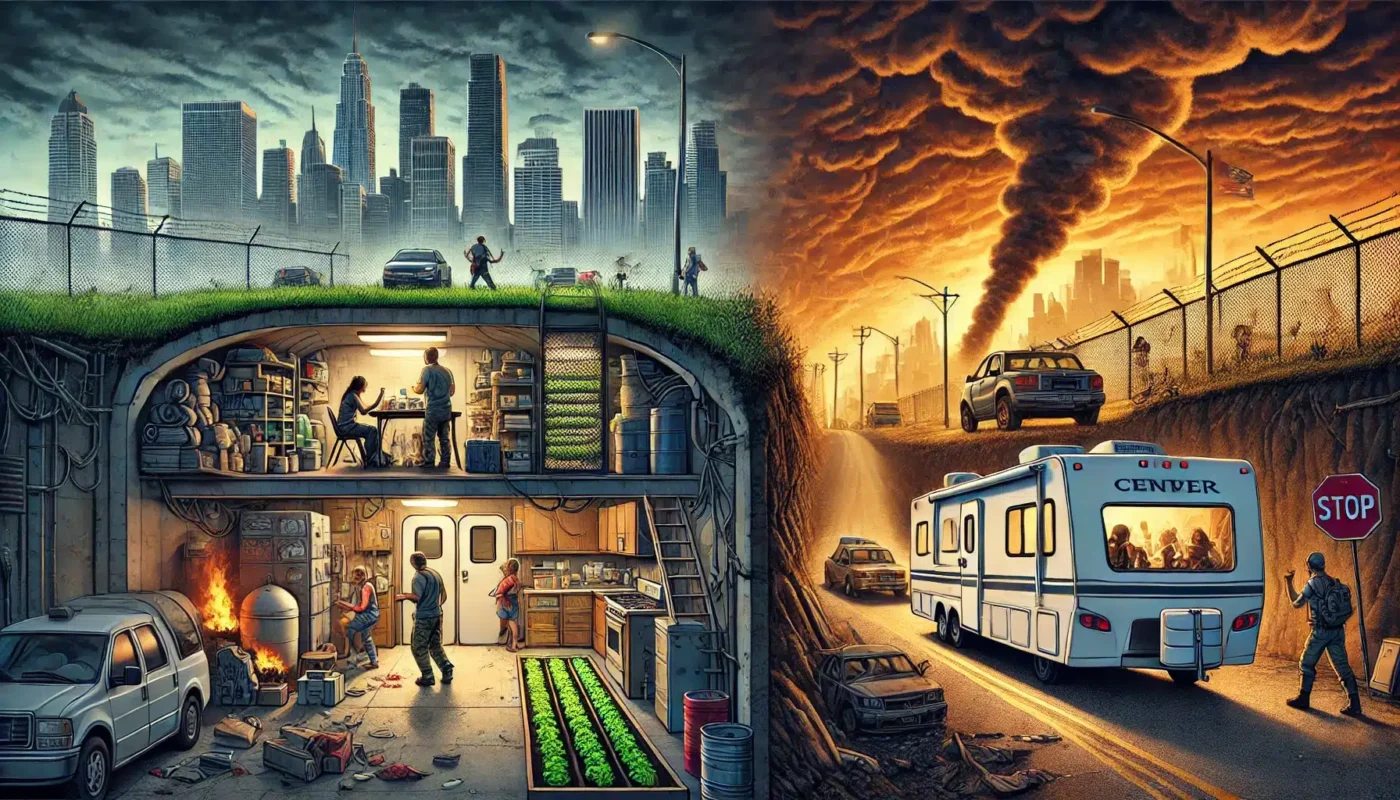Blog
Municipal survival options: should I stay or should I go?
Mastering the question “bug-in vs. bug-out” big city
By the first decision, every prepared household, when the alarms are meditating, whether to squeeze or set off on the road. Mobility buys a distance from danger, but the fortified home base promises thicker walls and deeper supplies.
Hurricane barrel towards the coast can promote blocking in a safe room, while unfolding the riots or a toxic leak can make the engine at idle your best friend. The only improper answer is to wait too long for improvising after critical time elements. (If the riots have already blocked the roads, your options become limited.)
Fortress option
Nothing competes with a properly designed bunker for brutal protection. Buried at least half of the Akra, poured with concrete and entwined with steel, underground retreat moves the shoulders of fire, stray bullets, and even short -term radiation.
However, achieving this level of security requires patience and documents. Plans must thread around gas, water and power lines. Local officials will want permits, and in dense districts they can never sign at all.
The bunker design means the space of the staging, the reinforced entrance must disappear in shaping the landscape, and air service tunnels, drainage and escapes must work flawlessly before the first shovel twists the soil.
Well done, the bunker becomes a hidden vault, in which the steel door will fray the upper chaos and concrete walls that keep both loot and weather.
Mobile … life on wheels
The family RV, on the other hand, disappears on the highway, offering beds, storage and kitchen that follows you along the road. Connect it with a compact tent, folding solar system and a portable filtration system, and the pavement itself turns into a moving basic camp.
Sometimes the safest place is every place, but here. When civil order breaks down or fire smoke paints the orange sky, speed and anonymity become priceless. A military -style truck looks hard, but screams “provides on board.”
The family RV, on the other hand, disappears on the highway, offering beds, storage and kitchen that follows you along the road. Connect it with a compact tent, folding solar system and a portable filtration system, and the pavement itself turns into a moving basic camp.
The art of pissing does not apply to power than in time – leaving before the gridlock sealing output seals – and about the discipline of the route, with paper maps and backreats, when GPS or cell towers fail.
Survival health as a critical multiplier
Steel doors and diesel engines are worthless if people are hungry, thirsty or sick. Each plan starts with water: at least a month in solid containers and a certain way of rain harvesting, snow melting or flowing on the roof.
Food follows the same logic-stable calories and survival garden, jars of sprouts or dehydrated greenery for real nutrition. A comprehensive first aid set connects the gap until professional care returns; Prescription and non -prescriptions are changed to slight injuries into experienced irritations. Rest also matters.
The rotating watches schedule allows everyone to fall asleep deep enough to fight the infection, think clearly and stop the morale from shaping.
Urban jungle coefficient
Most crises begin and spread in cities, and their problems are brutally specific. Crowds panic faster, emptying supermarkets within a few hours. Bridges and tunnels designed for everyday people commuting to work become iron traffic jams in every evacuation.
Forty -eight hours without water supply and water pump, noise fermentation and floor reheating apartment to the floor. Smoke hoods, many fire extinguishers and an alternative escape ladder become lives long before flying bullets.
City residents should examine water reservoirs in advance on the roof, fountains and industrial taps and learn to treat all flows. They should also assume that digital locks will appear the first in the centers of the population, transforming phones and road cameras into tracking tools, not amenities.
Hold your head, but be ready
Surviving in a packaged district is often a competition who is least noticed. Donemarking curtains hide the light of the generator, and the isolated cooking pots still tempt the aromas in the rooms. Clothing should mix – a gift, neutral, undeniable. No camouflage costumes and without tactical chest platforms on Main Street.
Digital footprints are the same as visual: a pre -paid phone closed in a Faraday bag of tracking the location, and the hard currency still seems when the power grid is not. The goal is to drift a landscape, such as background noise, invisible to both shells and authorities.
Flexible plans win when reality finally hits the fan
No strategy survived completely intact after the riots began. Build flexibility in every layer. If the fire makes the bunker a trap, the wheels are rolling. If the highways are chopping, paths and motorcycles take over. If the tap works dry, stored barrels buy time, and alternative sources are secured.
Start the “Co-if” with your family, turn the supplies before expiry and add new skills-from basic trauma care for gardening on the roof. Ready often is that it collects things than distinguishing and cultivating options.
Choose a reinforcement or wandering, but choose now. When the disaster finally hits the door, the only real luxury will be a reproduced direction, equipment already packed and confidence, while everyone else is still asking: “What just happened?”
If you haven’t thought about any of these problems before, let this weekend become your teacher. Most violence will actually be in internal cities. But the chaos spreads, know that.

